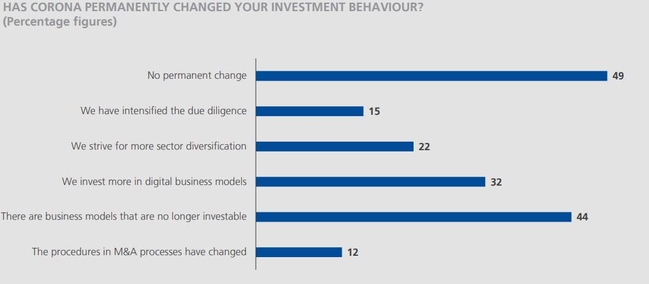Investment strategy has hardly changed – deal flow has returned to pre-pandemic levels
“Easings” and “lifting of restrictions” are on everyone’s lips – this is also true for the economy. Whether it is about lifting the obligation to work from home or lifting (business) travel restrictions, the re-opening of retail stores and restaurants, or the return of live seminars and conferences – the gloomy times that have been described as “once-in-a-century event” (Angela Merkel) and that, for example, promoted the use of economic instruments typical of wartimes in the United States seem to be over. Normality is returning, not only on a general basis, but also in the private equity sector. This is what the results of the most recent Midmarket Private Equity Monitor survey conducted by industry magazine FINANCE suggest.
The journal, together with Deutsche Beteiligungs AG (DBAG), regularly conducts an anonymous survey amongst investment managers of almost 50 mid-market private equity houses – most recently in the second half of May. Results can be summarised as follows: competition remains tight, pricing levels remain high and crisis management continues – but the investment strategy has hardly changed.
Around half of financial investors said that their investment behaviour had not changed because of the pandemic. And those investment managers who have observed changes in their investment behaviour reported that this mostly concerned the assessment of business models of potential M&A targets.

44 per cent – almost half of the surveyed PE investors – believe that some business models are no longer investable. Around one third are now tending to invest more into digital business models than before the pandemic. 22 per cent aim for more sector diversification, in order to be better equipped for the unexpected.
“The results show that the right conclusions have been drawn”, Torsten Grede, Spokesman of DBAG’s Board of Management, comments on the survey results. “During the pandemic, certain business models not only did not suffer – in fact, they gained momentum, including digital business models. In addition to that, it has become apparent just how valuable diversification is – which justifies aiming for more sector diversification”, Grede continues.
All in all, the implications on future investment behaviour have been limited – but what about investment opportunities during the pandemic? Looking back, crisis years have always turned out to be good for private equity. Right after the outbreak of the pandemic in spring 2020, transaction activity decreased substantially. “This is understandable”, DBAG’s Grede says, “concerns about the existing portfolio and the macroeconomic implications of the pandemic were paramount.” However, it soon became clear that while the pandemic would trigger a shock in the real economy, a crisis on the capital markets was not forthcoming – which was of course the case when the housing bubble burst in the United States in 2008. The M&A market soon overcame its shock, with investment volumes in 2020 falling short of 2019's record levels but still reaching decent levels such as in 2018.
Now, it seems as if the private equity market has weathered the pandemic. The competitive pressure from strategic investors has increased again. While back in December 2020, PE managers assessed their competitive position in M&A auctions to be as good as never before since the Midmarket Private Equity Monitor was launched in 2015, assigning it a value of 6.46 out of ten, this has since declined moderately to 6.29. However, the indicator assessing competition between funds in the PE sector has reached a new record high with 8.17 points ( December 2020: 8.09, June 2020: 6.83). This demonstrates how short the window of opportunity was last year when bold investors did not have as much competition when concluding M&A deals.

What’s next? The sector is clearly optimistic, reflected for example by the willingness to grow teams. More than half (56 per cent) of PE houses intend to do so. One year ago, only 46 per cent shared this view; 17 per cent envisaged having smaller teams, compared to only 5 per cent today. And as the buy-and-build strategy remains by far the most popular value enhancement method, the larger teams may remain busy over the coming months. Business as usual, it seems.


 Newsletter
Newsletter
 Contact
Contact
 Downloads
Downloads






